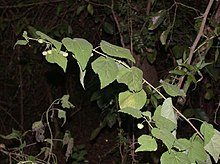
Ayenia limitaris

| Ayenia limitaris | |
|---|---|

| |
| Scientific classification | |
| Kingdom: | Plantae |
| Clade: | Tracheophytes |
| Clade: | Angiosperms |
| Clade: | Eudicots |
| Clade: | Rosids |
| Order: | Malvales |
| Family: | Malvaceae |
| Genus: | Ayenia |
| Species: | A. limitaris
|
| Binomial name | |
| Ayenia limitaris | |
| Synonyms | |
| |
Ayenia limitaris is a rare North American species of flowering plant in the mallow family known by the common names Rio Grande ayenia, Texas ayenia, and Tamaulipan kidneypetal. It is native to an area straddling the Rio Grande in Mexico and the United States. Today it is known from far southern Texas and far northern sections of the Mexican states of Coahuila and Tamaulipas. It has become rare because most of its habitat has been degraded or destroyed.[3] There are perhaps four populations remaining in Texas and two in Mexico, for a total of 1000 individual plants at most.[1] It is a federally listed endangered species of the United States.

This is a shrub growing up to 1.5 meters (5 feet) tall. The alternately arranged leaves have hairy heart-shaped blades with toothed edges. The small flowers have pinkish, greenish, or whitish petals. The fruit is a prickly capsule divided into five cells.

The plant's native habitat was made up of subtropical riparian woodland covered in dense thickets in the floodplains of the Rio Grande delta. It is probably adapted to periodic flooding in the area, an event that is largely contained and prevented today.[1][4] Only about 5% of the natural habitat, the Texas ebony-anacua (Ebenopsis ebano/Ehretia anacua) plant community, remains in this area.[5] the rest has been fenced and fragmented by roads, canals, and ditches, plowed for agricultural use, and compacted by herds of cattle.[3] Introduced plant species such as Guinea grass (Megathyrsus maximus) have taken hold.[4]

Metcalfa pruinosa, a true bug, feeds on the plant.[6]

References
- ^ a b c The Nature Conservancy
- ^ "Ayenia limitaris". Germplasm Resources Information Network. Agricultural Research Service, United States Department of Agriculture. Retrieved 2011-02-20.
- ^ a b Center for Plant Conservation Archived December 15, 2010, at the Wayback Machine
- ^ a b Texas Parks and Wildlife
- ^ USFWS. Determination of endangered status for the plants Ayenia limitaris and Ambrosia cheiranthifolia. Federal Register August 24, 1994.
- ^ USFWS. Texas Ayenia 5-year review: Summary and Evaluation.
External links
![]() Media related to Ayenia limitaris at Wikimedia Commons
Media related to Ayenia limitaris at Wikimedia Commons
![]() Data related to Ayenia limitaris at Wikispecies
Data related to Ayenia limitaris at Wikispecies

See what we do next...
OR
By submitting your email or phone number, you're giving mschf permission to send you email and/or recurring marketing texts. Data rates may apply. Text stop to cancel, help for help.
Success: You're subscribed now !

